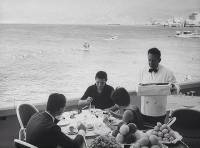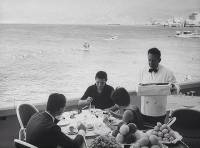
On the menu of 1970s Beirut, maps from all over the world.
Madame Gourmet debuted on July 2, 1971. Her invaluable culinary reviews were featured on page seven of the “Femme” section in the Culture et Loisirs supplement of L’Orient-Le Jour.
After 24 columns, the last of which appeared on Jan. 21, 1972, she vanished, leaving behind only her three fortnightly columns that reflected the tastes and costs of a bygone era.
That’s all we have in our archives about Madame Gourmet — a columnist so discreet that today, no one who worked with her at the newspaper remembers her real name.
But if we dissect her writings, one thing is certain: She had a refined palate. She was a true gourmet, sampling several dishes, pairing them with fine wines and never missing dessert. Above all, she was formidable, always getting the chef to divulge the recipe for the restaurant’s star dish.
She proudly published these recipes as trophies alongside her reviews, like a mousseline purée with tournedos.
By exploring the city’s most renowned establishments, she left behind a record of Beirut’s cosmopolitanism during its golden age, so fondly remembered by nostalgic souls. Which restaurants did she visit, and what impressions did she retain?
Let’s follow in the footsteps of this famous and mysterious columnist, the spiritual ‘mother’ of our current Cordon Courtine.
At La Pagode, on Phoenicia Street, Madame Gourmet noted that the cuisine of the Celestial Empire was light on the stomach and the wallet. “For four portions of the specialties, it won’t cost you more than 22 LL,” she wrote in July 1971.
At Myrtom House on Mexico Street, she praised the menu and the prices, noting that they had not risen for for seven years. Le Temporel in Yarzeh was described as “as dapper as a new penny.” Gilbert, the owner of La Portugesa, proudly adopted the slogan “the smallest restaurant in Beirut.”
L’Express in Hamra stood out as one of the few (if not the only) snack bars in the capital deserving the name of a restaurant. Le Flying Cocotte offered its “Plein Soleil” menu, which was not a new dance, but a special gastronomic menu served every evening starting 9 p.m.
Le Jean-Pierre was commended as “a restaurant with 20 years of excellence.” Degli Amici (formerly Régal) in Broummana gained fame for its “mini escalope for children” priced at LL2.75, which was a huge success.
For Madame Gourmet, the Elissar restaurant (opposite the American University of Beirut) was a delightful discovery. “Here, tomatoes take the form of roses. The presentation of each dish is as meticulous as a work of art, and this concern for decorum does not hide any unpleasant surprises, not even a weakness. On the contrary.”
Laodicée (Hamra Street, behind the Hotel Commodore) embraced the motto “good food at the best price.”
At Ristorante Italiano (Ain al-Mreisseh), the must-try items were, unsurprisingly, the Italian dishes. In particular, Madame Gourmet recommended the Milanese-style osso buco, accompanied by potatoes or rice, noting, “It’s a treat for Egyptians in Beirut.”
La Taverne Suisse (Georges Picot) has been discreetly delighting the capital’s gourmets for 19 years. L’Abbaye, a stone’s throw from the Souk Tawileh, offers Beirut residents a refreshing change of scene. Its Vietnamese owner has dedicated a large part of the menu to specialties from his homeland.
Madame Gourmet recommended La Nouvelle Chaumière (Sadat Street) for those dreaming of a quiet spot and Bali (at the Hôtel Riviera) for its Indonesian cuisine, which offers a total change of scene for the palate and attracts a clientele mainly consisting of Dutch people.
Madame Gourmet regretted that L’Oursin Libertin no longer serves sea urchins or oysters. “Under the new management of Monique Lèvent, the former owner of a restaurant in Cannes, the entire menu has been infused with garlic, rosemary, basil and the various herbs that are de rigueur in Provençal cuisine.”
At Alfonso, on Badaro Street, the food critic noted the cheerful atmosphere and praised the abbachio alla romana — suckling lamb with rosemary — and the marsala sabayon.
As for the Relais de Normandie, it seemed to have finally found its stride after previous iterations as a “Viking” restaurant and a “snack bar.” Madame Gourmet observed that it now had the right formula with Corine, an authentic Norman from Granville, who not managed the reception and contributed to the kitchen, sharing her culinary secrets with the chef and meticulously checking the sauces.
“The Balkans? This restaurant is well worth a visit, if only for its excellent gypsy ensemble,” said Madame Gourmet. The atmosphere is picturesque and cheerful, which is significant, but there’s more. The cuisine, authentically Balkan — like the owner who has been seamlessly moving between the dining room and the kitchen for the last eight years — is just as excellent.
This article was originally published in L'Orient-Le Jour and translated by Sahar Ghoussoub.
